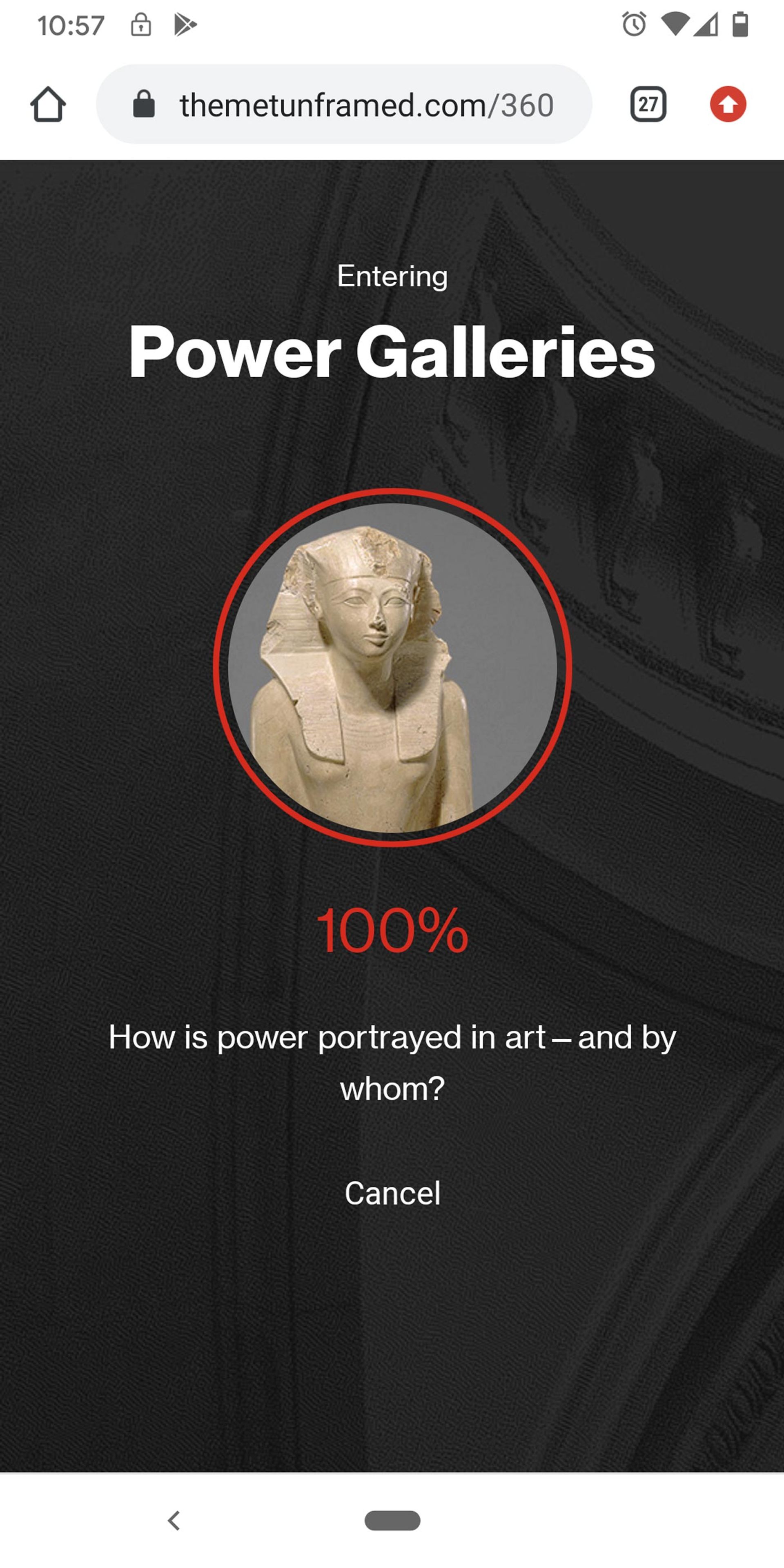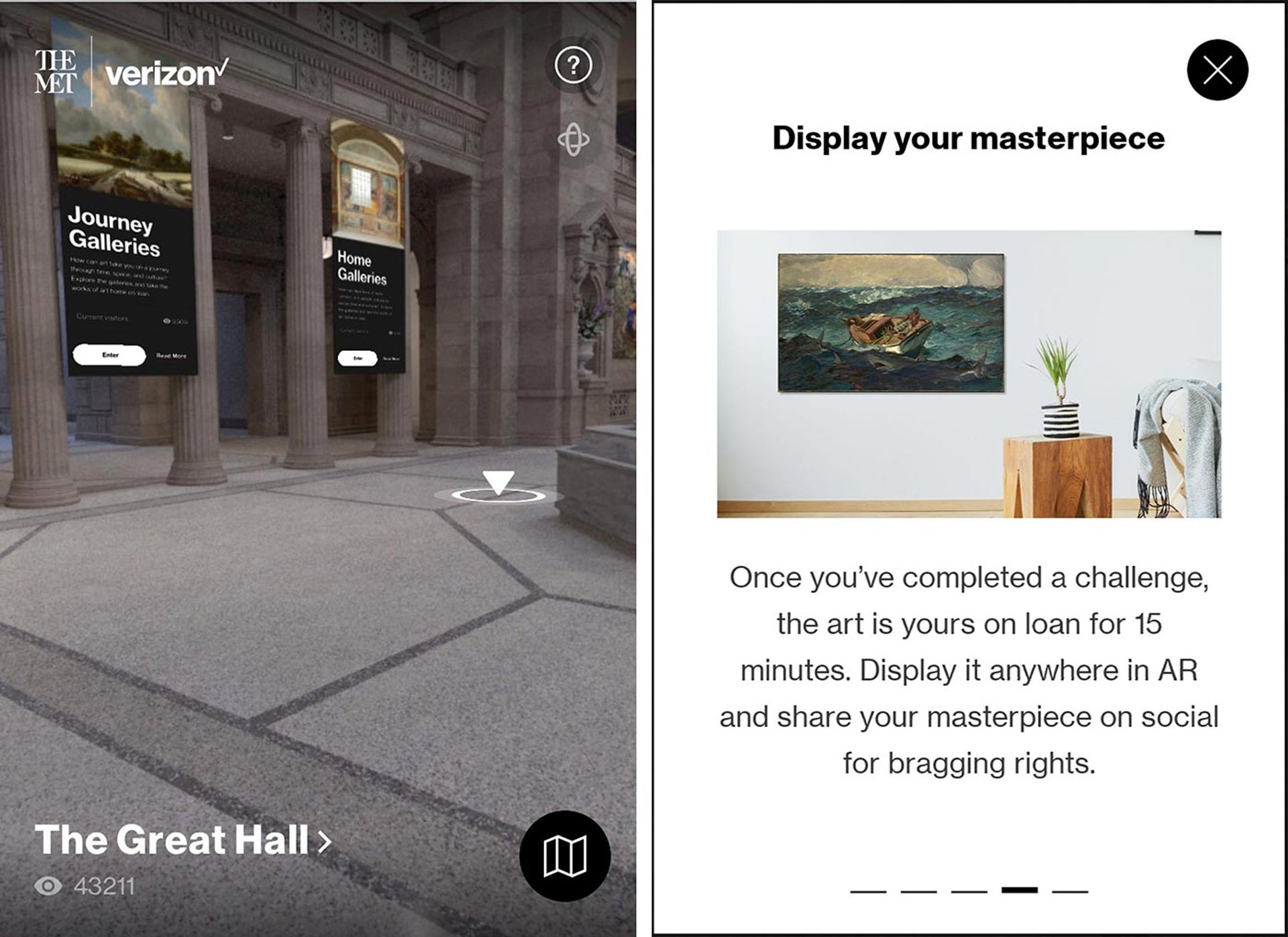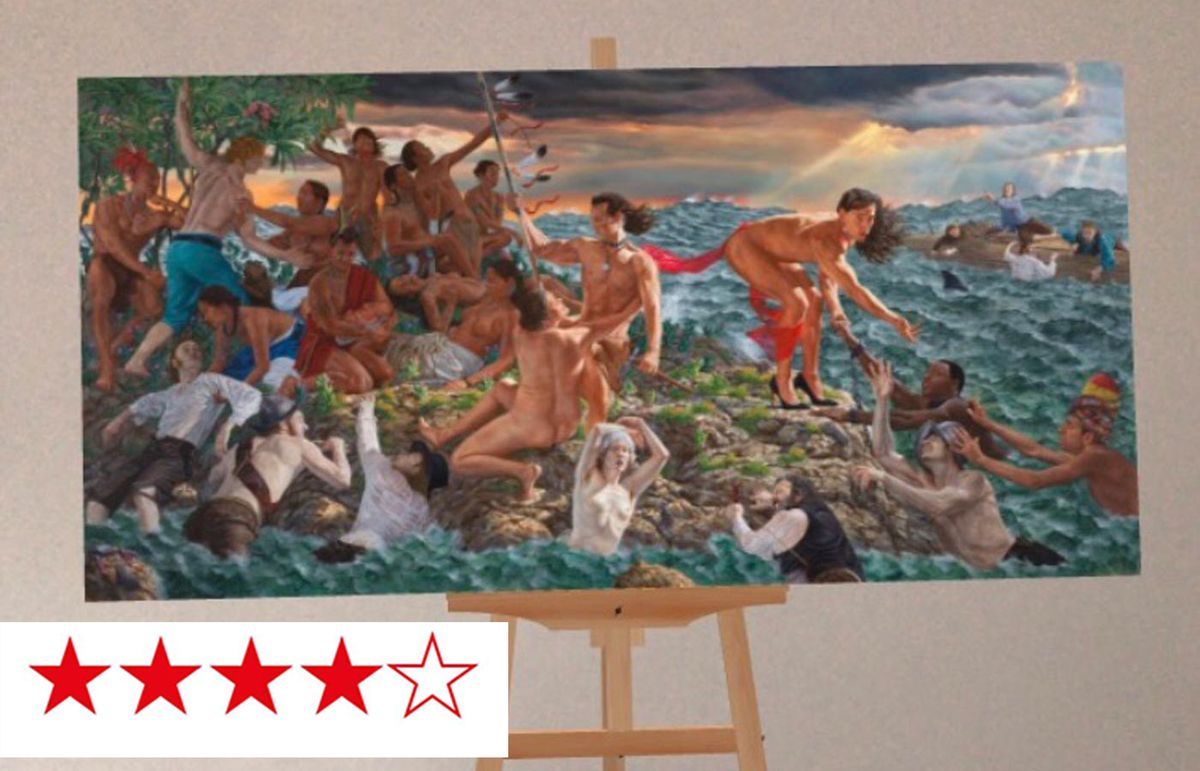What is it?
The Met Unframed is an interactive, gamified, mobile-only virtual experience of the Metropolitan Museum of Art, New York, curated under four themes. Users solve in-experience puzzles to view works of art from the museum as time-limited loans in their own virtual spaces.
Produced by: Verizon. Created by: Unit9 with the Met's digital, educational, and curatorial teams providing rich content and curation.
They Say
The Met Unframed opens virtual doors to the Museum, offering immersive access to digital galleries and augmented reality versions of iconic Met masterpieces
We Say
The Met Unframed lets you visit the museum, not just the works in its collection
Curator’s note
The last time this panel reviewed an XR experience from the Metropolitan Museum of Art in New York, we were grappling with the question of where, in the modern home, was the ritualistic ingestion of hallucinogens most appropriate? The Zemí Cohoba Stand allowed you to take an object home while The Met Unframed seeks to transport you out of your quarantine and into the museum.
There have always been multiple ways to visit the Met. When not able to take the subway uptown, you could watch Gossip Girl or read Ben Lerner’s The Topeka School or, more famously, Donna Tartt’s The Goldfinch.
The Met Unframed is a new way to visit the Met where the XR experience, produced by Verizon, drops you in the museum's Great Hall, a place usually overrun with school groups and tourists and where, during this time of the year—and if there were not a pandemic limiting visitors—you would probably find a coat-check line a mile long. In XR, the Met’s lobby is peaceful. Quiet music plays and when you select a themed room to enter, footsteps echo as you navigate around.

The Met Unframed offers a choice of four themed exhibitions
The exhibitions are divided by themes, two of which nod to quarantine: Exploring Home and Journeys. I, to no one's surprise, was most interested in the Power-themed exhibition.
The Met, which is usually hung by chronology and origin, offered through this exhibition The Seated Statue of Hatshepsut (New Kingdom, 1479-1458 BC) in the same room as Emanuel Leutze’s Washington Crossing the Delaware (1851). I’m going to guess, given the value and risk of physical movement, they don’t move Hatshepsut from the Eqyptian wing very often.
It was wonderful that the curators took advantage of the virtual opportunity to display the work next to Washington Crossing the Delaware. Especially as I have always been fascinated by this painting because it is a fiction masquerading as a history. The American flag displayed in it had not yet been designed at the time of Washington’s crossing in 1776. To see it there is to see how power uses art to reinforce itself.
I’d love to see it hung next to Jacques-Louis David’s The Coronation of Napoleon which is in the Louvre's collection. The mother of Napoleon, Letizia Bonaparte, was in Rome during her son's coronation in Paris, but she, along with Napoleon's brother, who was also not present at the event, was painted as if there.
What does it really mean to the truth for us to see artistic proof of something in XR that is not physically so? Through The Met Unframed you, like Napoleon’s mum at her son’s coronation, weren’t at the Met but you also sort of were.
—Gretchen Andrew
Is it accessible? And to whom?
Users have the option to place the 3D models virtually on the floor, on the wall or on an easel. A thoughtful nod to the fact that only a minutely small percentage of the global population lives in an uncluttered white cubeLouis Jebb
Gretchen Andrew: As the experience is not platform specific it is relatively accessible. It is also well designed and easy to use. However, it is unclear why the experience “closes” so soon, instead of remaining accessible.

The experience is well designed and easy to follow
Louis Jebb: It is a plus to be able to enter The Met Unframed via a web link—rather than having to download an app first. The user instructions are clear, copious, and friendly rather an over-didactic, making the viewer complicit in the challenge. Users have the option to place the 3D models virtually on the floor, on the wall or on an easel. A thoughtful nod to the fact that only a minutely small percentage of the global population lives in an uncluttered white cube. As with all AR experiences, you will need good natural light and a strong mobile/WiFi connection for optimal performance.
Lans King: For novice XR users, the clear step-by-step instructions at the initiation make this experience rather easy to navigate. They should be comfortable with the interface within two minutes. Of course, it’s second nature for those who are used to these types of applications or even first-person video games.
From a critical, art historical standpoint, how good is the art? In what ways does it continue important conversations in art history in theme, medium or message?
The works are well selected and contextualised. Yet, they transverse a variety of art historical eras, regions, and movements. This serves to demonstrate how similar ideas and subject matters are revisited at every epoch.Lans King
Gretchen Andrew: The work in The Met Unframed is, well, in the Met, both virtually and physically. It has definitely passed the test of art historical importance. Yet, the experience does not rely solely on the established grandeur of the Met’s collection. By placing works like The Seated Statue of Hatshepsut and Washington Crossing the Delaware in the same room, the curation furthers conversations about power in a way much easier in VR. Considering the value and risks, I assume neither of these works are carted around much.
Louis Jebb: The Met curators, well-served by the production verve of Unit9, must have had a lot of fun in choosing the works, and how best to combine and augment them. By using a variety of works with broad appeal, they make the puzzle aspect of The Met Unframed inviting to a wide audience. And by creating a generous number of virtual galleries, they offer up the possibility of one day turning these spaces and the 3D renders of the museum's stock into an educational, or professional, tool, where students or budding curators could create a portfolio of virtual exhibitions, or challenge the Met's staff, virtually, to change the way the collection is curated.
Lans King: The Met offers an excellent visit by broad themes such as Journey. The works are well selected and contextualised. Yet, they transverse a variety of art historical eras, regions, and movements. This serves to demonstrate how similar ideas and subject matters are revisited at every epoch.
What medium-specific qualities of VR/AR does it employ? What is gained by enjoying this in VR/AR rather than In Real Life?
I’m really interested in the way The Met moved its collection around in ways it would have hesitated to In Real LifeGretchen Andrew
Gretchen Andrew: I’m really interested in the way The Met moved its collection around in ways it would have hesitated to In Real Life. The Art Newspaper's XR panel will be exploring this year how museums can do more of this and more easily loan physical objects digitally.
Louis Jebb: The Met Unframed shows the potential of VR/AR to go close, to examine in detail, to show under-drawing and preliminary sketches; and the power of the medium to add visual and curatorial wit, to augment the fun. I was intrigued from the moment I saw the trailer videos in which Leutze’s Washington Crossing the Delaware is animated, ice flows and all, and a waterfall playfully flows over the frame on Frederick Edwin Church's Heart of the Andes.
Lans King: The experience makes good use of the VR spatial orientation techniques in particular. One gets the sense that they are indeed moving through the museum with works curated and organised according to a narrative. It’s a guided visit, yet it allows the user to choose their own path. Unlike in the real museum, the gamification promotes a deeper consideration of the works. Furthermore, the AR features allow the visitor to visualise the works on the walls of their homes.
Does it break new ground technically?
Gretchen Andrew: Going forward, we think it remains important for this panel to consider the vanguard of technology and where its edge is being applied in the cultural space.
Louis Jebb: The Met Unframed makes generous, slick and intelligent use of established VR and AR techniques, which should encourage other institutions looking to start down the XR road.
Lans King: The application uses tested and proven VR/AR techniques. Whilst there is no new ground broken, the overall application of these technologies is solid. Displacement is rather fluid via the functionality of the gyroscope. Even though we are able to zoom in, the small screen of a smartphone has its limits when it comes to viewing art. I tried using my tablet, however, I was not able to make it work.
What does it say about the future of the medium/art form/ use of XR within the art world?
Gretchen Andrew: The barriers that allow works from the Met’s collection to move around in digital space are not only physical but cultural, legal, and technical. The fact that the Met’s first experience with the Zemi Cohoba Stand allowed an indefinite AR experience but The Met Unframed time-limits how long you can keep works shows a growing awareness of the complex cultural space that AR creates, both for better and worse.
Louis Jebb: It shows the long-term potential for the Met to make their virtual spaces and 3D models available to would-be curators. As an educational tool. With a further opportunity to bring into the equation neglected parts of the museum's stock from across its 150-year history—pieces that might no longer be of world importance but have a story to tell when mixed with marquee works or standout acquisitions.
Lans King: For those who are not able to visit top museums and galleries in person (pretty much everyone at the moment), these experiences are compelling. For those who have easy access to art institutions, XR technologies can allow them to deepen their appreciation and knowledge. I’m truly looking forward to the democratisation of XR goggles and glasses!
The XR panel's ratings
Gretchen Andrew gave a rating of 4/5 stars.
Louis Jebb gave a rating of 4/5 stars.
Lans King gave a rating of 4/5 stars.
Giving an overall panel rating of 4/5 stars.
The Art Newspaper’s XR Panel
Gretchen Andrew hacks systems of power with art, glitter and code. Her next exhibition is with Annka Kultys in Spring 2021.
Louis Jebb founded immersiv.ly, a pioneer in the use of virtual reality in news coverage, in 2014. He launched The Art Newspaper's XR Panel in July 2020.
Lans King is an interdisciplinary artist. He has become known for his radical artwork for which he has surgically implanted an NFC microchip into his hand. His ongoing project, The Hyperreality Show, blurs the lines between the real and the virtual, the analog and digital, humanity and technology. His work includes painting, videos, installations, sculpture, digital, and his signature painting-video hybrids.


